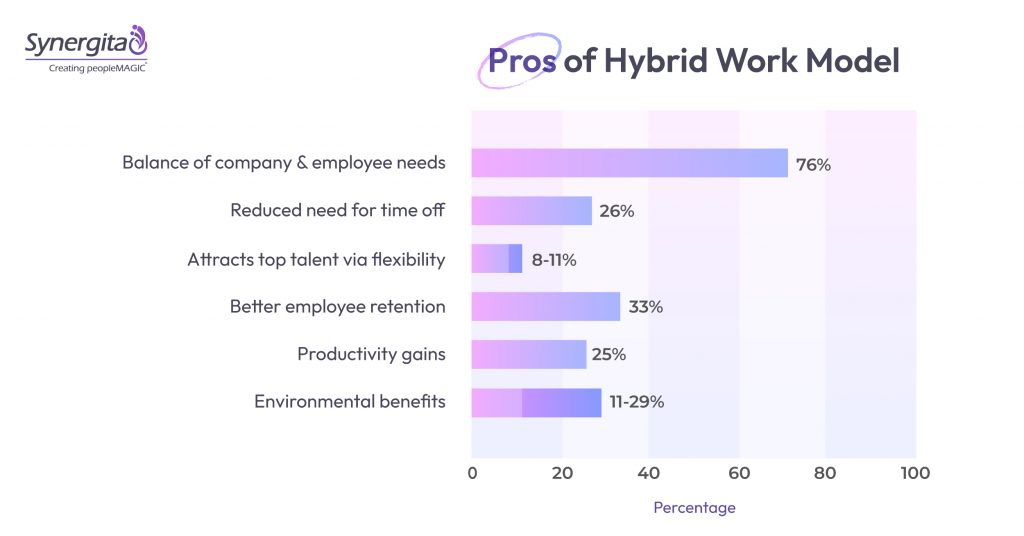Hybrid working style opened the floodgates. You are now flooded with both positives and negatives. But you don’t have to put up with the negatives. This blog will teach you how to fix the challenges in hybrid team management and improve the positive aspects. You can basically fix these challenges using OKR and goal setting in hybrid work. Continue reading to know why hybrid work fails, pros and cons of hybrid work and how to adapt them into your company.
Why Do Hybrid teams fail?
Hybrid teams fail for diverse reasons if you are not paying close attention to what you are doing and where you are going. Here are 6 ways companies miss hybrid team alignment:
1. Lack of Clear Structure and Guidelines
70% of companies don’t have a formal hybrid work strategy (Microsoft, 2023)
When companies leave hybrid work “optional” or vague, teams don’t know when to come in, when to collaborate, or how to coordinate. This leads to confusion, siloed teams, missed opportunities for collaboration, and weakened culture.
2. Leadership Proximity Bias
30–40% of remote employees (especially women and minorities) report being overlooked for promotions and key projects
When leaders physically see only a part of the team regularly, they may unconsciously favor in-person staff for advancement and recognition. This erodes trust and morale over time.
3. Weakened Cross-functional Collaboration
Hybrid workers report a 20–30% drop in informal learning and knowledge sharing
Spontaneous interactions, quick problem-solving chats, and informal mentorships happen less in hybrid settings, especially when teams are split. As a result, innovation and cross-team alignment suffer.
4. Technology Fragility
85% of hybrid workers say technical issues disrupt productivity at least once a week
Hybrid work relies heavily on robust IT systems, reliable networks, secure remote access, and proper equipment. Any tech gaps (hardware failures, VPN issues, security breaches) immediately stall work, frustrate employees, and reduce efficiency.
5. Blurring of Work-Life Boundaries
Nearly 40% of hybrid workers say they struggle to “switch off” after work hours
Without clear boundaries, employees often extend work into personal time, leading to burnout, mental fatigue, and eventual disengagement — defeating one of hybrid work’s intended benefits.
6. Diverse Work Style Preferences Causing Inconsistent Output
Employees thrive under different work conditions — some need social energy, others need solitude.
In hybrid setups, one employee may be highly productive from home while another struggles without real-time team access. Managers face challenges balancing these needs fairly. Without tailored support, this creates uneven performance across the team, inconsistency in outcomes, and frustration on both sides.
Pros of Hybrid Work Model

- Balance of Company and Employee needs
- Less need of Time offs for the employees
- Attracting higher parentage of talented work force due to flexibility
- Better employee retention
- Increased productivity by saving time and energy it takes to being present inside the office
- Cost saving for company (in terms of real estate, electricity, utilities, and overhead cost), and for employees (in terms of traveling and other work-related expenses)
- Better for a greener and healthier planet (the benefit to the environment comes in the form of low carbon emission and energy consumption)
Cons of Hybrid Work Model

- Limited to no exposure to leadership
- Reduced viability of cross functional team collaboration
- Increased possibility of being overlooked
- Increased chances of work disruption due to technology dependence
- Dependency of robust cyber security systems.
- Work-life balance for employees (yes, it is in both places, a pro and a con. There are instances this model blurs the boundaries)
Adapting OKR for Hybrid Teams
Start with brutal clarity.
Hybrid teams thrive on crystal-clear expectations. A 2023 study by Gartner found that “lack of role clarity reduces team performance by 25% in hybrid settings.” OKRs slice through ambiguity by making every objective visible, measurable, and time-bound — whether someone’s in-office or remote.
Translate objectives into daily relevance.
According to a McKinsey report (2023), 74% of hybrid employees feel disconnected from their company’s long-term vision. OKRs bridge that gap. When employees see how their weekly key results link directly to company priorities, motivation spikes.
Make accountability location-proof.
Physical proximity no longer guarantees progress visibility. Harvard Business Review (HBR, 2023) noted that hybrid managers often struggle to track contributions fairly. OKRs force transparency — everyone’s progress is updated, reviewed, and visible in real-time dashboards.
Inject agility into rigid routines.
Hybrid environments are fluid. OKRs aren’t static—they allow quarterly reviews, pivots, and refinements, keeping teams aligned even when external conditions shift.
Humanize performance.
Hybrid work blurs personal-professional boundaries. OKRs offer structure without micromanagement—empowering employees to own outcomes while respecting flexibility.


